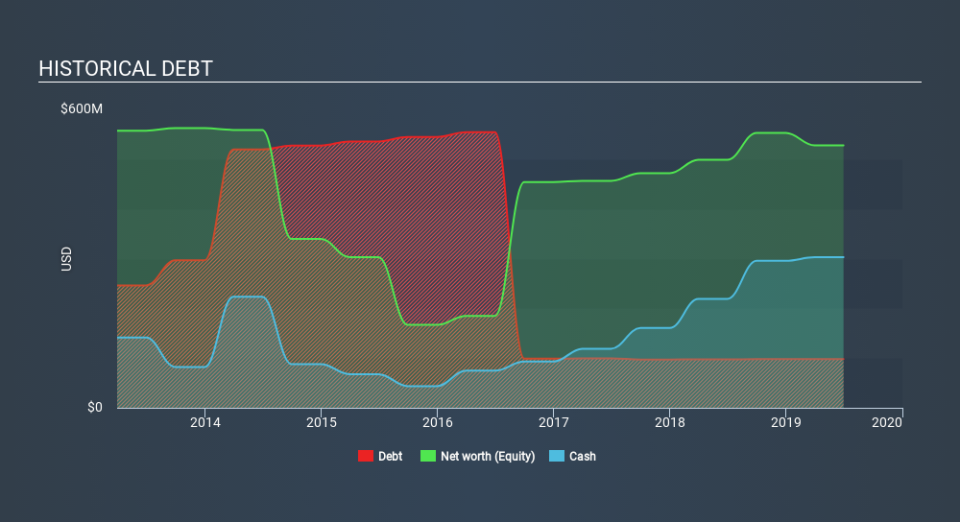Is Gulf Keystone Petroleum (LON:GKP) A Risky Investment?

Legendary fund manager Li Lu (who Charlie Munger backed) once said, 'The biggest investment risk is not the volatility of prices, but whether you will suffer a permanent loss of capital. When we think about how risky a company is, we always like to look at its use of debt, since debt overload can lead to ruin. As with many other companies Gulf Keystone Petroleum Limited (LON:GKP) makes use of debt. But is this debt a concern to shareholders?
Why Does Debt Bring Risk?
Debt is a tool to help businesses grow, but if a business is incapable of paying off its lenders, then it exists at their mercy. Part and parcel of capitalism is the process of 'creative destruction' where failed businesses are mercilessly liquidated by their bankers. While that is not too common, we often do see indebted companies permanently diluting shareholders because lenders force them to raise capital at a distressed price. Of course, the upside of debt is that it often represents cheap capital, especially when it replaces dilution in a company with the ability to reinvest at high rates of return. The first step when considering a company's debt levels is to consider its cash and debt together.
See our latest analysis for Gulf Keystone Petroleum
What Is Gulf Keystone Petroleum's Net Debt?
As you can see below, Gulf Keystone Petroleum had US$98.0m of debt, at June 2019, which is about the same the year before. You can click the chart for greater detail. But it also has US$302.7m in cash to offset that, meaning it has US$204.7m net cash.
How Strong Is Gulf Keystone Petroleum's Balance Sheet?
We can see from the most recent balance sheet that Gulf Keystone Petroleum had liabilities of US$123.2m falling due within a year, and liabilities of US$121.6m due beyond that. Offsetting these obligations, it had cash of US$302.7m as well as receivables valued at US$66.6m due within 12 months. So it actually has US$124.4m more liquid assets than total liabilities.
This surplus suggests that Gulf Keystone Petroleum is using debt in a way that is appears to be both safe and conservative. Due to its strong net asset position, it is not likely to face issues with its lenders. Succinctly put, Gulf Keystone Petroleum boasts net cash, so it's fair to say it does not have a heavy debt load!
On top of that, Gulf Keystone Petroleum grew its EBIT by 76% over the last twelve months, and that growth will make it easier to handle its debt. The balance sheet is clearly the area to focus on when you are analysing debt. But it is future earnings, more than anything, that will determine Gulf Keystone Petroleum's ability to maintain a healthy balance sheet going forward. So if you're focused on the future you can check out this free report showing analyst profit forecasts.
Finally, while the tax-man may adore accounting profits, lenders only accept cold hard cash. While Gulf Keystone Petroleum has net cash on its balance sheet, it's still worth taking a look at its ability to convert earnings before interest and tax (EBIT) to free cash flow, to help us understand how quickly it is building (or eroding) that cash balance. Happily for any shareholders, Gulf Keystone Petroleum actually produced more free cash flow than EBIT over the last three years. That sort of strong cash conversion gets us as excited as the crowd when the beat drops at a Daft Punk concert.
Summing up
While it is always sensible to investigate a company's debt, in this case Gulf Keystone Petroleum has US$204.7m in net cash and a decent-looking balance sheet. And it impressed us with free cash flow of US$97m, being 167% of its EBIT. The bottom line is that we do not find Gulf Keystone Petroleum's debt levels at all concerning. Above most other metrics, we think its important to track how fast earnings per share is growing, if at all. If you've also come to that realization, you're in luck, because today you can view this interactive graph of Gulf Keystone Petroleum's earnings per share history for free.
If, after all that, you're more interested in a fast growing company with a rock-solid balance sheet, then check out our list of net cash growth stocks without delay.
If you spot an error that warrants correction, please contact the editor at editorial-team@simplywallst.com. This article by Simply Wall St is general in nature. It does not constitute a recommendation to buy or sell any stock, and does not take account of your objectives, or your financial situation. Simply Wall St has no position in the stocks mentioned.
We aim to bring you long-term focused research analysis driven by fundamental data. Note that our analysis may not factor in the latest price-sensitive company announcements or qualitative material. Thank you for reading.

 Yahoo Finance
Yahoo Finance 
